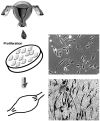Myogenic transdifferentiation of menstrual blood-derived cells
- PMID: 18646568
- PMCID: PMC2949303
Myogenic transdifferentiation of menstrual blood-derived cells
Abstract
Cells with myogenic potential are present in many tissues, and these cells readily form skeletal muscle in culture. We here focus on menstrual blood as another cell source for regenerative medicine. Menstrual blood-derived cells have high replicative ability, similar to progenitors or stem cells, and transdifferentiate or meta-differentiate into myocytes in vitro at unexpectedly high frequencies. This unique phenotype can be explained by histological and embryological aspects of the endometrium. The remarkable myogenic capability of these cells enables us to "rescue" dystrophied myocytes of the mdx model of Duchenne muscular dystrophy through cell fusion and transdifferentiation. Endometrial cells supplied as a form of menstrual blood-tissue mixture can be used for cell-based therapy in addition to a place for embryo implantation.
Figures

Similar articles
-
Menstrual blood-derived cells confer human dystrophin expression in the murine model of Duchenne muscular dystrophy via cell fusion and myogenic transdifferentiation.Mol Biol Cell. 2007 May;18(5):1586-94. doi: 10.1091/mbc.e06-09-0872. Epub 2007 Feb 21. Mol Biol Cell. 2007. PMID: 17314403 Free PMC article.
-
Protein O-mannosylation is crucial for human mesencyhmal stem cells fate.Cell Mol Life Sci. 2016 Jan;73(2):445-58. doi: 10.1007/s00018-015-2007-y. Epub 2015 Aug 6. Cell Mol Life Sci. 2016. PMID: 26245304 Free PMC article.
-
Skeletal Muscle Differentiation on a Chip Shows Human Donor Mesoangioblasts' Efficiency in Restoring Dystrophin in a Duchenne Muscular Dystrophy Model.Stem Cells Transl Med. 2016 Dec;5(12):1676-1683. doi: 10.5966/sctm.2015-0053. Epub 2016 Aug 8. Stem Cells Transl Med. 2016. PMID: 27502519 Free PMC article.
-
Plasticity of human menstrual blood stem cells derived from the endometrium.J Zhejiang Univ Sci B. 2011 May;12(5):372-80. doi: 10.1631/jzus.B1100015. J Zhejiang Univ Sci B. 2011. PMID: 21528491 Free PMC article. Review.
-
Stem cell therapy for muscular dystrophies.J Clin Invest. 2020 Nov 2;130(11):5652-5664. doi: 10.1172/JCI142031. J Clin Invest. 2020. PMID: 32946430 Free PMC article. Review.
Cited by
-
Improved osteogenic differentiation by extremely low electromagnetic field exposure: possible application for bone engineering.Histochem Cell Biol. 2022 Oct;158(4):369-381. doi: 10.1007/s00418-022-02126-9. Epub 2022 Jun 25. Histochem Cell Biol. 2022. PMID: 35751679 Free PMC article.
-
Endometrial Stem Cell Markers: Current Concepts and Unresolved Questions.Int J Mol Sci. 2018 Oct 19;19(10):3240. doi: 10.3390/ijms19103240. Int J Mol Sci. 2018. PMID: 30347708 Free PMC article. Review.
-
Can Human Embryonic Stem Cell-Derived Stromal Cells Serve a Starting Material for Myoblasts?Stem Cells Int. 2017;2017:7541734. doi: 10.1155/2017/7541734. Epub 2017 Jun 15. Stem Cells Int. 2017. PMID: 28706537 Free PMC article.
-
Endometrial Mesenchymal Stem Cells Isolated from Menstrual Blood by Adherence.Stem Cells Int. 2016;2016:3573846. doi: 10.1155/2016/3573846. Epub 2015 Nov 23. Stem Cells Int. 2016. PMID: 26681948 Free PMC article.
-
Novel therapeutic strategies for injured endometrium: intrauterine transplantation of menstrual blood‑derived cells from infertile patients.Stem Cell Res Ther. 2023 Oct 15;14(1):297. doi: 10.1186/s13287-023-03524-z. Stem Cell Res Ther. 2023. PMID: 37840125 Free PMC article.
References
-
- Alhadlaq A, Mao JJ. Mesenchymal stem cells: isolation and therapeutics. Stem Cells Dev 2004;13:436-48. - PubMed
-
- Toyoda M, Takahashi H, Umezawa A. Ways for a mesenchymal stem cell to live on its own: maintaining an undifferentiated state ex vivo. Int J Hematol 2007;86:1-4. - PubMed
-
- Pittenger MF, Mackay AM, Beck SC, et al. Multilineage potential of adult human mesenchymal stem cells. Science 1999;284:143-7. - PubMed
-
- Sekiya I, Larson BL, Vuoristo JT, et al. Adipogenic differentiation of human adult stem cells from bone marrow stroma (MSCs). J Bone Miner Res 2004;19:256-64. - PubMed
-
- Okamoto K, Miyoshi S, Toyoda M, et al. “Working” cardiomyocytes exhibiting plateau action potentials from human placenta-derived extraembryonic mesodermal cells. Exp Cell Res 2007;313:2550-62. - PubMed
Publication types
MeSH terms
LinkOut - more resources
Full Text Sources
Other Literature Sources
Medical
